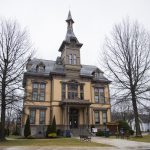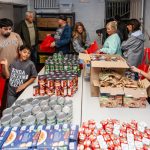SAUGUS — In 2022, a vote came to Town Meeting on whether murals should be considered separate from signage bylaws. The drafted article would allow murals and public artworks to be installed on private property under certain criteria. Ultimately, it was voted down. However, Cultural Council Co-Chair Tori Darnell is hoping to bring a new policy back to Town Meeting regarding the subject.
Darnell recently completed an 8-month ChangeMakers program with Creative County Initiative, a program under the Essex County Community Foundation (ECCF).
Here, Darnell collaborated with other creative leaders to build a more inclusive and sustainable arts and culture ecosystem.
Darnell is the first person from Saugus to complete the program and participate in any ECCF initiative. She also received a $1,000 grant from the program, which will be applied to public art programs in town.
“The idea is that we’re all coming together in ways that we feel like could help promote more of a sense of a wholesome community in a way that we know who our neighbors are (and) we’re here to serve them in different ways,” she said.
Darnell felt it was important for her, as co-chair of the Council, to see how she could better serve the community.
She noted that in 2024, the ECCF held an arts and cultural summit in Beverly, and when speaking to a board chair of the Creative County Initiative, the woman said they had never met someone from Saugus who was a part of what they were doing.
After telling the woman some of the visions she had for the town, she told Darnell that she should apply to the ChangeMakers program.
“During this program I knew this was going to be my focus,” Darnell said.
The head of the Mass Cultural Council spoke during the program, highlighting the importance of policy in the sense of art and infrastructure.
“He saw it as just like how we think about bridges, roads, improvements, and whatnot. Art and art centers can help with that narrative of the infrastructure of the community,” Darnell said.
She said she realized that there wasn’t something inherently wrong with the bylaw and the approach of the town because they were just trying to preserve the historic, natural, and general town aesthetics.
“I can’t be against that. I think it’s a very admirable thing to do, especially as part of the zoning bylaws,” Darnell said. “However, I don’t think murals should be on the same playing field as billboards and building signs.”
She said a policy that clearly defines what public art is for Saugus would be a better path to go down. Through feedback from the program, peers, and networking, Darnell was able to think about Saugus through a more creative lens.
“I’m not looking, nor do I think the town of Saugus should just copy and paste what Lynn has done, or Salem, or any other community nearby, but we should be very intentional about the identity of Saugus and how we’d like to curate that for the community,” she said.
As of right now, the policy is being framed with a statement of purpose, the why. It also has to look at who will be making the decisions.
“I really want it to be an open discussion with people in Town Meeting and those in the community to sort of raise their voices on what they would like to see in Saugus. I feel like when you have more voices at the table to be able to talk about these things, you get a really better picture of how to serve this community more effectively and have them represented in this space,” he said.
Darnell said the main reason she is doing this is because when she moved to town in 2021, she was out in the neighborhood with her son, who was five at the time, and as they walked around, her son asked, “Where’s the art?” In that moment, Darnell realized there wasn’t anything painted in town.
Darnell felt she had grown up with privilege in the way that her mom took the time to take her to art museums and go see art.
“To me, art shouldn’t be a privilege thing to see. People should be able to see it wherever they go. It should be a reflection of what is in that community… If a community decides what artwork is being painted on a wall or a structure, or an installation, it’s a reflection of those around it. It’s meant to bring conversation. It’s supposed to bring people together,” she said.




